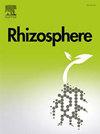Stem rot affects the structure of rhizosphere microbiome in berseem clover (Trifolium alexandrinum)
IF 3.4
3区 生物学
Q1 PLANT SCIENCES
引用次数: 0
Abstract
Rhizosphere microbiome plays an essential role in maintaining plant health and productivity.
Fungal and bacterial diseases may affect the rhizosphere-associated microbial communities and overall structure of plant microbiome. Here, we studied the effect of stem rot of berseem clover on the bacterial and fungal communities associated with the rhizosphere. We analyzed the rhizosphere-associated bacterial and fungal microbiome from healthy and infected berseem clover collected from three sampling sites by using 16S rRNA and ITS based Illumina sequencing metabarcoding approach. Microbiome analysis showed that healthy plants had higher bacterial and fungal diversity as compared to stem rot infected plants. At the genus level, bacterial genera Rhizobium and Comamonas were more abundant in healthy plants while Pantoea was more abundant in infected plants and fungal genera Sclerotinia, Fusarium and Podospora were more abundant in infested plants while Rhizoglomus and Cladosporium were distinctively abundant in healthy Berseem. Functional characterization of bacterial and fungal microbiomes revealed that bacterial communities from infected plants showed more abundance of bacteria with functions replication and repair, enzyme families and biosynthesis of other secondary metabolites as compared to healthy plant microbiome and decreased in fungal groups including arbuscular mycorrhiza and soil saprotrophs and an increase in plant saprotrophs and fungal parasite-plant pathogens. This study provides comprehensive information about the structure and composition of bacterial and fungal communities associated with the berseem clover rhizosphere that could be utilized for future research on the control of stem rot of berseem clover.
茎腐病对三叶草根际微生物群结构的影响
根际微生物群在维持植物健康和生产力方面起着至关重要的作用。真菌和细菌病害可能影响根际相关微生物群落和植物微生物群的整体结构。本文研究了黄三叶草茎腐病对根际细菌和真菌群落的影响。采用16S rRNA和基于ITS的Illumina测序元条形码方法,对3个采样点的健康和感染三叶草根际相关细菌和真菌微生物群进行了分析。微生物组分析表明,与茎腐病植株相比,健康植株具有更高的细菌和真菌多样性。在属水平上,健康植株中根瘤菌属和单胞菌属较多,感染植株中泛菌属较多,侵染植株中菌核菌属、镰刀菌属和足孢菌属较多,健康植株中根瘤菌属和枝孢菌属较多。细菌和真菌微生物组的功能特征表明,与健康植物微生物组相比,感染植物的细菌群落中具有复制和修复功能、酶家族和其他次生代谢物生物合成的细菌数量更多,真菌类群(包括丛枝菌根和土壤腐养菌)的数量减少,植物腐养菌和真菌寄生虫-植物病原体的数量增加。本研究提供了有关三叶草根际细菌和真菌群落结构和组成的全面信息,可为今后三叶草茎腐病防治的研究提供依据。
本文章由计算机程序翻译,如有差异,请以英文原文为准。
求助全文
约1分钟内获得全文
求助全文
来源期刊

Rhizosphere
Agricultural and Biological Sciences-Agronomy and Crop Science
CiteScore
5.70
自引率
8.10%
发文量
155
审稿时长
29 days
期刊介绍:
Rhizosphere aims to advance the frontier of our understanding of plant-soil interactions. Rhizosphere is a multidisciplinary journal that publishes research on the interactions between plant roots, soil organisms, nutrients, and water. Except carbon fixation by photosynthesis, plants obtain all other elements primarily from soil through roots.
We are beginning to understand how communications at the rhizosphere, with soil organisms and other plant species, affect root exudates and nutrient uptake. This rapidly evolving subject utilizes molecular biology and genomic tools, food web or community structure manipulations, high performance liquid chromatography, isotopic analysis, diverse spectroscopic analytics, tomography and other microscopy, complex statistical and modeling tools.
 求助内容:
求助内容: 应助结果提醒方式:
应助结果提醒方式:


